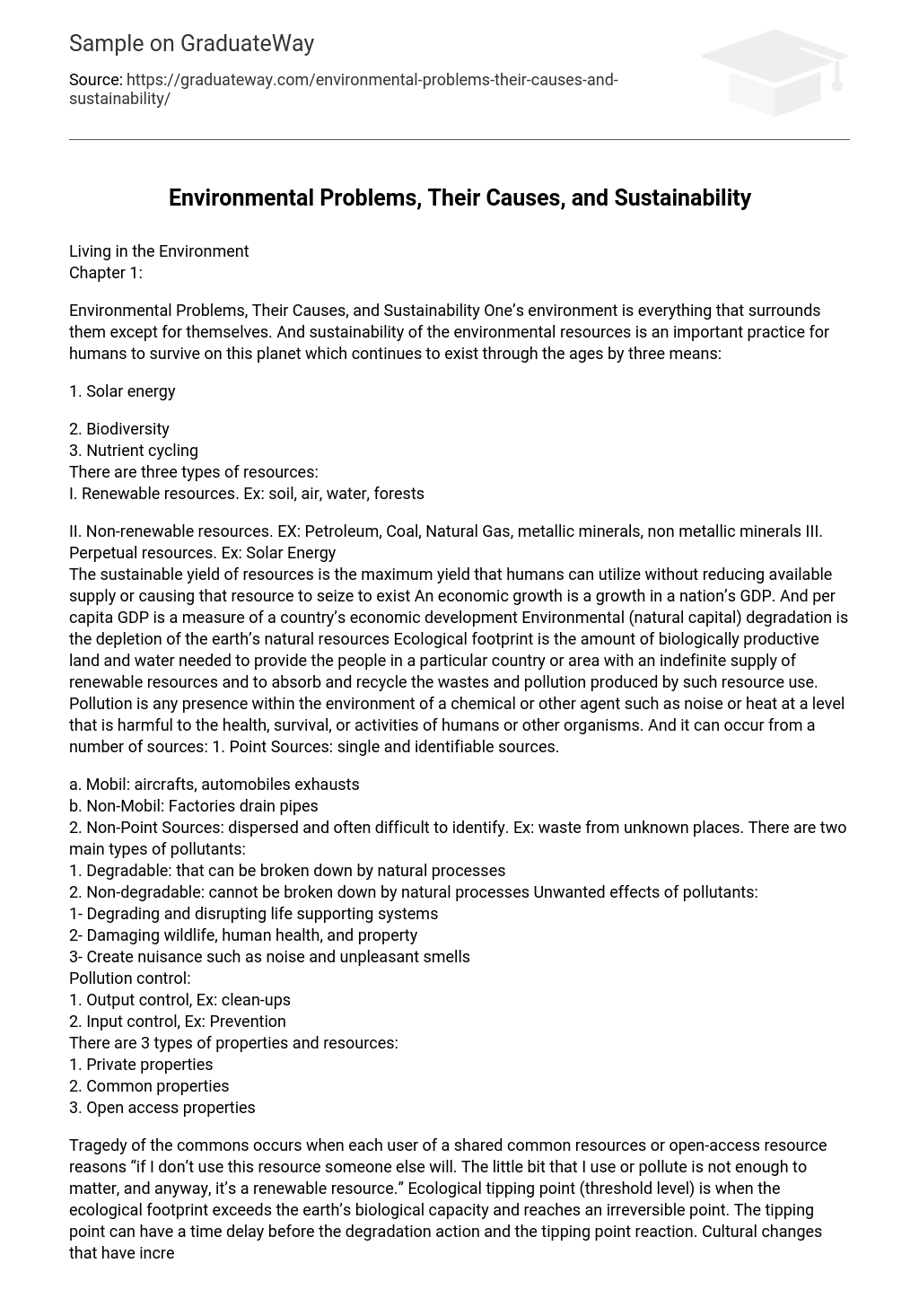Living in the Environment
Chapter 1:
Environmental Problems, Their Causes, and Sustainability One’s environment is everything that surrounds them except for themselves. And sustainability of the environmental resources is an important practice for humans to survive on this planet which continues to exist through the ages by three means:
1. Solar energy
2. Biodiversity
3. Nutrient cycling
There are three types of resources:
I. Renewable resources. Ex: soil, air, water, forests
II. Non-renewable resources. EX: Petroleum, Coal, Natural Gas, metallic minerals, non metallic minerals III. Perpetual resources. Ex: Solar Energy
The sustainable yield of resources is the maximum yield that humans can utilize without reducing available supply or causing that resource to seize to exist An economic growth is a growth in a nation’s GDP. And per capita GDP is a measure of a country’s economic development Environmental (natural capital) degradation is the depletion of the earth’s natural resources Ecological footprint is the amount of biologically productive land and water needed to provide the people in a particular country or area with an indefinite supply of renewable resources and to absorb and recycle the wastes and pollution produced by such resource use. Pollution is any presence within the environment of a chemical or other agent such as noise or heat at a level that is harmful to the health, survival, or activities of humans or other organisms. And it can occur from a number of sources: 1. Point Sources: single and identifiable sources.
a. Mobil: aircrafts, automobiles exhausts
b. Non-Mobil: Factories drain pipes
2. Non-Point Sources: dispersed and often difficult to identify. Ex: waste from unknown places. There are two main types of pollutants:
1. Degradable: that can be broken down by natural processes
2. Non-degradable: cannot be broken down by natural processes Unwanted effects of pollutants:
1- Degrading and disrupting life supporting systems
2- Damaging wildlife, human health, and property
3- Create nuisance such as noise and unpleasant smells
Pollution control:
1. Output control, Ex: clean-ups
2. Input control, Ex: Prevention
There are 3 types of properties and resources:
1. Private properties
2. Common properties
3. Open access properties
Tragedy of the commons occurs when each user of a shared common resources or open-access resource reasons “if I don’t use this resource someone else will. The little bit that I use or pollute is not enough to matter, and anyway, it’s a renewable resource.” Ecological tipping point (threshold level) is when the ecological footprint exceeds the earth’s biological capacity and reaches an irreversible point. The tipping point can have a time delay before the degradation action and the tipping point reaction. Cultural changes that have increased humans’ ecological footprint are: 1. Agricultural revolution
2. Industrial revolution
3. Information-globalization revolution
Environmental disruptions are mainly caused by:
1. Over population
2. Unsustainable resource use
3. Poverty
4. Exclusion of environmental costs from the overall production cost Affluence has harmful environmental effects like:
1. High levels of consumption
2. High levels of pollution
3. Unnecessary waste of resources
And beneficial effects in providing funds to develop technologies to reduce: 1. Pollution
2. Environmental degradation
3. Resource waste
Poverty has harmful environmental and health effects such as: 1. Malnutrition
2. Premature death
3. Limited access to clean water and sanitized facilities
Living sustainably means living off the earth’s natural income without depleting the natural capital that provides it. Environmentally sustainable society meets current needs while ensuring the needs of future generations will be met Three big ideas:
1- Rely on renewable and perpetual energy
2- Protect and restore Bio-diversity
3- Sustain natural cycle by reducing waste





